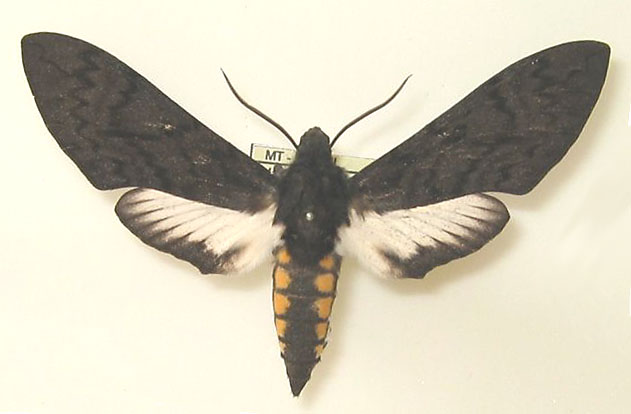Manduca violaalba
(B. P. Clark, 1922)

Manduca violaalba, Brazil, courtesy of Eurides Furtado.
This site has been created by
Bill Oehlke at oehlkew@islandtelecom.com
Comments, suggestions and/or additional information are welcomed by Bill.
TAXONOMY:
Family: Sphingidae, Latreille, 1802
Subfamily: Sphinginae, Latreille, [1802]
Tribe: Sphingini, Latreille, 1802
Genus: Manduca Hubner, 1807 ...........
Species: violaalba B. P. Clark, 1922
|
DISTRIBUTION:
Manduca violaalba (wingspan: 73-83mm; forewing length: approximately 39mm)
flies in cerrado habitats in Brazil (specimen type locality) in Mato Grosso; Mato Grosso do Sul; Goias; Maranhao: Federal District;
Minas Gerais.
This species should be easy to identify due to almost completely uniform dark grey-brown almost black ground colour of the forewings. Markings are
dark black and distinct and there usually is a small white dot in the cell area.
The hindwing is white with a dark, dentate band along the outer margin.

Manduca violaalba male, Burity, Mato Grosso, Brazil,
courtesy of Ian Kitching, myspecies website.
FLIGHT TIMES:
Manduca violaalba adults fly in October-November, and possibly in other months.

Manduca violaalba, 73mm, Brazil, courtesy of Jean Haxaire

Manduca violaalba, 83mm, Brazil, courtesy of Jean Haxaire
ECLOSION:
Pupae probably wiggle to surface from subterranean chambers just prior to eclosion.
SCENTING AND MATING:
Females call in the males with a pheromone released from a gland at the tip of the
abdomen. Adults take nectar from flowers.

Manduca violaalba, 81mm, Brazil, courtesy of Jean Haxaire
EGGS, LARVAE, PUPAE:
Larva have been reported on ??
Return to Sphingidae Index
Return to Sphingini Tribe




